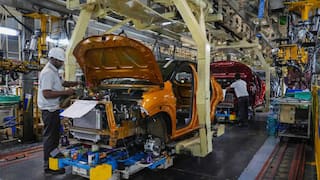Vapourised Rock Rain, Sunburned Atmosphere — Bizarre Conditions Found On Hot-Jupiters
Jupiter-sized planets are so precariously close to their parent star that they are being roasted at seething temperatures above 3,000 degrees Fahrenheit, hot enough to vapourise most metals.

New Delhi: Hubble astronomers studying ultra-hot Jupiters have found evidence of bizarre weather conditions on the sizzling worlds. Jupiter-sized planets are so precariously close to their parent star that they are being roasted at seething temperatures above 3,000 degrees Fahrenheit, hot enough to vapourise most metals, including titanium. These world's have the hottest planetary atmospheres ever seen.
Vapourised Rock Rain And “Sunburned” Atmosphere
The researchers have described their findings in two new papers. One of the papers, published on April 7 in the journal Nature, is about a planet where it is raining vapourised rock. The other paper, published in the Astrophysical Journal Letters, is about a planet which has its upper atmosphere getting hotter rather than cooler because it is being "sunburned" by intense ultraviolet radiation from its star.
The astronomers have not just found weird and quirky planet atmospheres, but have also gained better insights into the diversity, complexity, and exotic chemistry taking place in different worlds across the Milky Way galaxy, the study said.
ALSO READ | Hubble Detects How Planet Forms Through 'Intense And Violent' Process, Orbiting A Young Star
In a NASA statement, David Sing of the Johns Hopkins University in Baltimore, Maryland, who co-authored the two studies, said researchers still do not have a good understanding of the weather in different planetary environments. He added that when one looks at Earth, all weather conditions are still finely tuned to what can be measured. But when one looks at a distant exoplanet, they have limited predictive powers because a general theory about how everything in an atmosphere goes together and responds to extreme conditions has not been built, Sing said. He added that even though one knows the basic chemistry and physics, they don't know how it is going to manifest in complex ways.
Daytime Side Of One Planet Enriched In Silicon Monoxide
The study published in Nature describes a planet called WASP-178b, which is located 1,300 light-years away. The atmosphere on the daytime side is cloudless, and is enriched in silicon monoxide gas. Since one side of the planet permanently faces its star, the torrid atmosphere whips around to the nighttime side at super-hurricane speeds exceeding 2,000 miles per hour, according to the study.
Rock Rain On The Dark Side
The silicon monoxide on the dark side may cool enough to condense into rock that rains out of clouds, but even at dawn and dusk, the planet is hot enough to vapourise rock.
Josh Lothringer, who co-authored both studies, said the researchers knew they had seen something really interesting with the silicon monoxide feature.
Super-Hot Jupiter Receives Blast Of UV Light From Parent Star
In the study published in the Astrophysical Journal Letters, Guangwei Fu of the University of Maryland, College Park, reported on a super-hot Jupiter, KELT-20b, located about 400-light years away, on which a blast of ultraviolet light from its parent star is creating a thermal layer in the atmosphere, much like Earth's stratosphere. Fu said until now, researchers never knew how the host star affected a planet's atmosphere directly, but now, they have the first observational data.
UV Radiation Is Heating Metals In Planet's Atmosphere
On Earth, the ozone in the atmosphere absorbs ultraviolet light and raises temperatures in a layer between seven to 31 miles above the planet's surface. On KELT-20b, the ultraviolet radiation from the star is heating metals in the atmosphere. This makes for a very strong thermal inversion layer, according to the study. An inversion layer is a region or layer of the atmosphere in which the temperature stops decreasing with elevation and instead becomes warmer.
Hubble had detected water in near-infrared observations, and NASA's Spitzer Space Telescope had detected carbon monoxide. This is how the astronomers obtained evidence of a “sunburned” atmosphere above KELT-20b.
Water & Carbon Monoxide Radiate Through Hot Atmosphere Of Planet
The water and carbon monoxide radiate through the hot, transparent upper atmosphere that is produced by the inversion layer. According to the study, this signature is unique from what astronomers see in the atmospheres of hot-Jupiters orbiting cooler stars, like our Sun.
Fu explained that the emission spectrum for KELT-20b is quite different from other hot-Jupiters, and said this is compelling evidence that planets do not live in isolation but are affected by their host star.
The studies help pave the way to better understand the atmospheres of potentially inhabitable terrestrial planets. Lothringer said the research is a test of scientists' techniques that allows them to build a general understanding of physical properties such as cloud formation and atmospheric structure.
Related Video
Southern Rising Summit 2024: How Important is Self-Awareness? Insights from Anu Aacharya | ABP LIVE






































